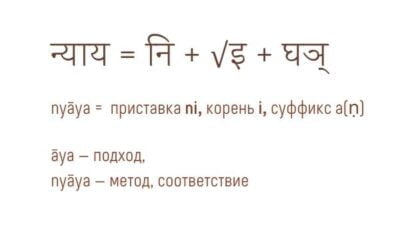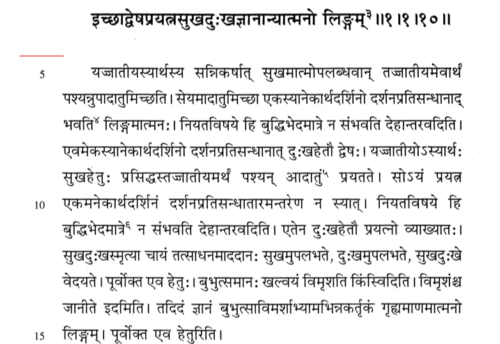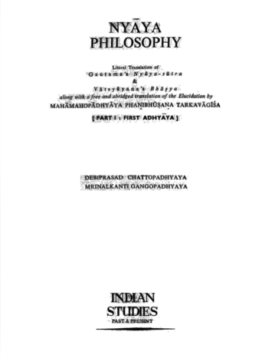Nyaya
Nyaya Sutras
The author is Akshapada Gautama. Date of creation – the beginning of our era. The total number of sutras (statements) is 529 in five chapters.
There are many commentaries on The Nyaya, the most authoritative are three:
The Nyaya Bhashya, by Vatsyayana, circa 4th century;
The Nyaya Bhashya Varttika, by Bharadwaja Uddhyotakara, circa 6th century;
The Nyaya Varttika Tatparyatika by Vachaspati Mishra, circa 9th century AD.
Nyaya
Дебаты по методу ньяи проходят и сегодня в Индии на санскрите.
The meaning of 'nyaya' term

The word nyaya is formed from the root i “to go” with the suffix a, forming a masculine noun, by the prefix ni.
Outside the philosophical context, the word nyaya has these meanings:
Nyaya philosophy.
M.Gangopadhyaya
Nyaya philosophy. Literal tranlsation of Gautama's Nyayasutra and Vatsyayana's Bhashya. Part I - First adhyaya.(M.Gangopadhyaya)(Calcutta,1967)
Translation of some Nyaya Sutras
The sutras in this block are translated by participants of the «Sanskrit in Ukraine» project.
Sutras 1.1 and 1.2
On the thirst for knowledge
The Cogniser desires to understand the coveted object both from the explanation of the authority and by observing the attributes [of the object]. [The Cogniser] desires to see directly that which has been cognised by seeing the attributes. When the object is directly cognised, then the thirst for cognition disappears.
The Nyaya Bhashya, the Commentary on Sutra 1.1.2.
On Discussion
As we know, a discussion is a set of statements in which there is more than one speaker, in which evidence for each of the theses is provided, and which concludes by certifying the correctness of one of the two theses.
The Nyaya-bhashya, commentary on Sutra 1.1.1.
On trolling
[The above-mentioned] discussion and debate have a motive. Trolling, on the other hand, will be described now. A troll is someone who acts by trolling. If he acts [by trolling], but it turns out that he has a certain position and system of views which he reveals when questioned, [then] he is not a troll. If [someone] says that [his] motive is to inform about a contradiction in his opponent’s position, then that too is not trolling. And if [someone] acts by informing, knowing through whom [the interlocutor] is informed, as well as the one who is being informed [himself], there is no trolling in such [action] either. If [someone] does not act in such a way as to inform about the contradiction in the opponent’s position – such his speech will be meaningless. A troll is one whose speeches are extensive but devoid of substantiation. If he acts in such a way that the object [of discussion] is determined, such his position is to be established. If he does not act in such a way that the object of discussion is determined], then [the dialogue] will be mere idle chatter devoid of meaning.
The Nyaya Bhashya, commentary on 1.1.1 sutra.
On rebirth
Having a cause, the next birth is conditioned by activity [in the current birth].
Rebirth, being endowed with atman, occurs through the destruction and subsequent reconnection of the stream consisting of the body, senses, cognitive abilities, and [bodily] sensations.
The Nyaya Bhashya, commentary on sutra 1.1.2.
Sutra 9
On cognisable objects
The objects of cognition are atman, the body, the organs of sense and sensation, [their] objects, cognition, attention, activity, vices, rebirth, the fruits [of actions], suffering, and final liberation.
Sutra 1.1.9.
Characteristics of cognisable objects, including the atman
Among them is atman – observing everything, tasting everything, experiencing everything. The body is the place where the pleasure of this [atman] is localised. The sense organs are the means of attaining enjoyment. The objects of the senses are such that they can be enjoyed.
Cognition is a pleasure
Cognition is savouring (pleasure).
The Nyaya-bhashya, commentary on Sutra 1.1.9.
Sutra 10

Nyaya on the existence of atman
The attributes of atman are desire, aversion, effort, pleasure, suffering and cognition.
Sutra 1.1.10.
Desire as proof of the existence of atman
The Atman desires to obtain an object of precisely the kind it has previously cognised as pleasant. This [recollection] would be impossible in the context of merely separate acts of cognition, the object of which is defined as if they had taken place in another body.
Disgust as proof of the existence of atman
Disgust [takes place] in relation to the cause of suffering, because the one who sees many objects recalled observing [suffering].
Pleasure as proof of the existence of atmanPleasure as proof of the existence of atman
Observing, [the atman] desires to acquire an object of exactly the kind that was [previously] known to him as the cause of pleasure.
Effort as proof of the existence of atman
This is the effort that cannot take place without a single observer of different objects recalling the observation. It cannot take place in the context of only individual acts of cognition, whose object is defined as if they took place in a different body. In the same (way) the effort is explained in relation to the cause of suffering.
Cognition as a proof of the existence of atman
He who acquires the means of comprehension, by means of the recollection of the pleasant and the unpleasant, cognises the pleasant, cognises the unpleasant, feels the pleasant and the unpleasant. The reason for this has been given above. It is known that desiring to cognise, he reflexes “why?”. And reflexively, he cognises it. And this knowledge is a sign of atman, as long as it is perceived as something that has an identical subject to the subject of the desire to know and the subject of reflection.
Nyaya in Sanskrit with commentaries
The Nyaya Sutras with the Commentaries by Bhashya Vatsyayana
Thakkur Publishing House
The Nyaya Sutras, provided with the Commentaries by Vatsyayana Bhashya.
The Commentaries were compiled 3-4 centuries after the dating of the Sutras.
The Nyaya Sutras with Bhashya-varttika sub-commentary
Thakkur Publishing House
The Nyaya Sutras, with the Bhashya-varttika sub-commentary by Bharadwaja Uddhyotakara.
The sub-commentary was composed around the 6th century after the dating of the Sutras.



